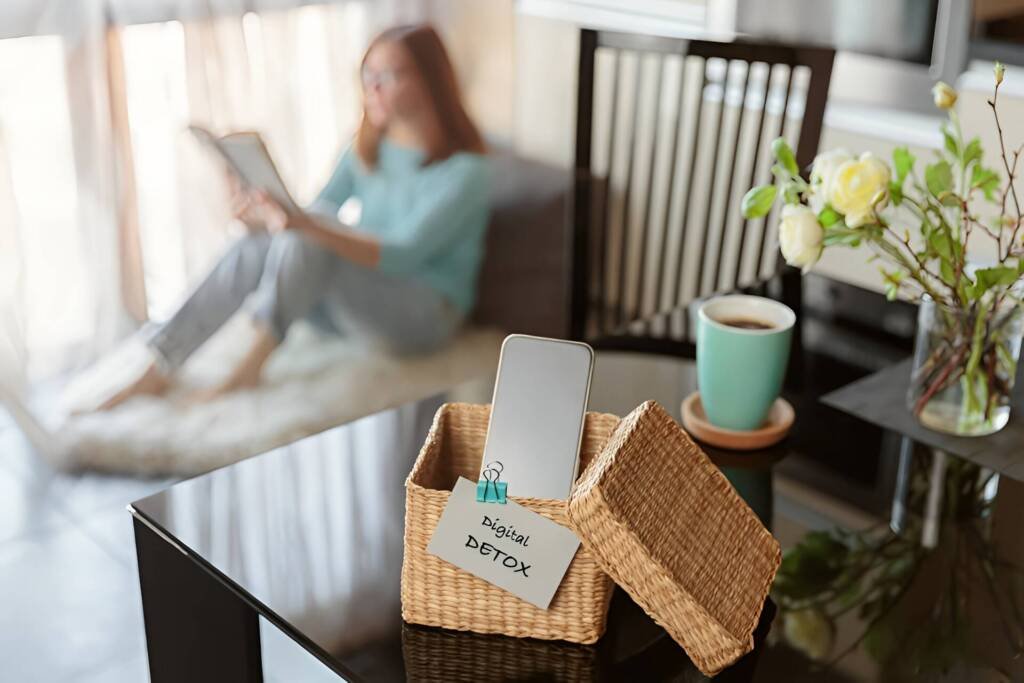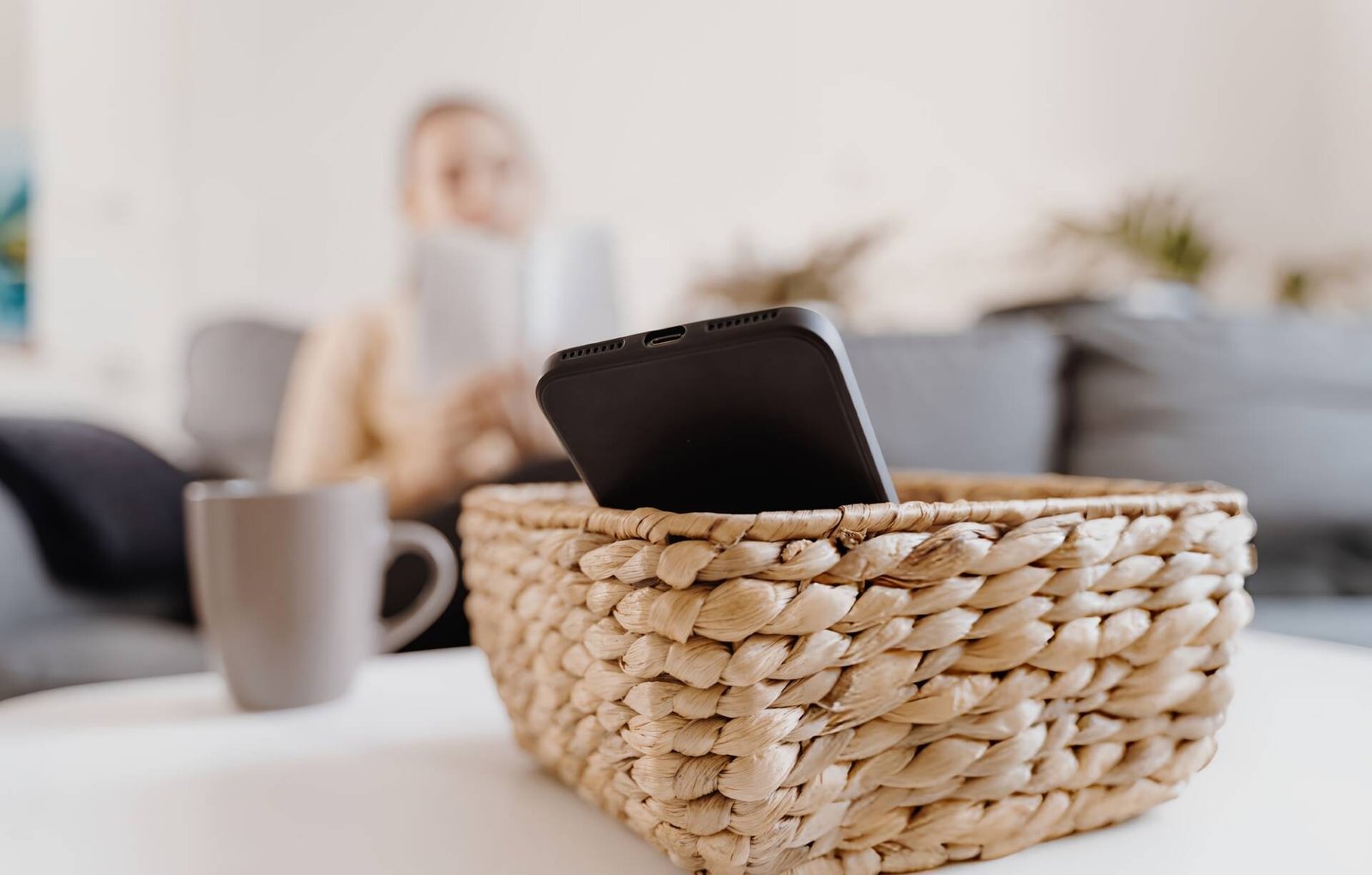It’s 7 a.m., and your day has already started with a flurry of notifications. Throughout the day, you juggle Zoom meetings, emails, and endless scrolling—only to end the night staring at your phone in bed, wondering where the time went. Sound familiar?
As much as technology has enriched our lives, it’s also become a double-edged sword. Screen fatigue is rising, negatively impacting our focus, productivity, sleep, and relationships. But the good news? You don’t need to ditch technology altogether to reclaim balance. By integrating mindful living practices and rethinking how we use tech, we can reduce digital overwhelm and rediscover what it means to really live.
Table of Contents
This guide will show you how digital detoxing and mindful living can help combat screen fatigue, strengthen your relationships, and foster a healthier balance with technology.
Why We All Need a Digital Detox?

First, what exactly is a “digital detox”? Simply put, it’s a break from screens to recalibrate your habits and reconnect with what truly matters offscreen, such as spending time with loved ones, engaging in hobbies, or simply enjoying the present moment. It doesn’t mean cutting technology out of your life ultimately, which can feel unrealistic in today’s world.
Instead, a digital detox is about finding balance, setting boundaries, and using technology with intention. Whether it’s limiting social media, reducing screen time before bed, or designating tech-free zones, a digital detox helps you reset and develop healthier habits.
The Impact of Screen Fatigue
Did you know the average adult spends more than 7 hours a day looking at screens? Research links excessive screen time to issues like reduced sleep quality, declining attention spans, and increased stress levels. Blue light exposure disrupts your circadian rhythm, while the endless habit of “doomscrolling” can leave you feeling mentally drained.
Signs you might need a detox include constant phone checking, struggling to stay focused, or feeling disconnected from loved ones. You might also find yourself scrolling aimlessly on weekends or missing out on meaningful conversations because a notification stole your attention.
Even temporarily, detoxing is one of the simplest ways to reduce these effects and regain control of your time.
The Intersection of Mindfulness and Technology

Mindfulness is the practice of living in the present moment, fully engaged without judgment. When applied to technology, mindfulness doesn’t mean avoiding devices altogether—it’s about creating intentionality.
Instead of mindlessly reaching for your phone, mindful tech use encourages asking, “Why am I using this right now? Is it serving me, or am I just avoiding something?” For example, you might choose to turn off your phone during dinner to savor your meal or set clear limits for social media. Over time, these small but impactful changes can help you create harmony with your devices.
Mindfulness empowers us to engage with technology in a way that enriches rather than dominates our lives.
Tips to Combat Screen Fatigue with Mindful Practices

1. Schedule Breaks with the Pomodoro Technique
The Pomodoro Technique is a popular time management system that helps you stay focused and productive by breaking your work into manageable chunks. The method involves working for 25 minutes, known as a “Pomodoro,” followed by a 5-minute break to recharge. After completing four Pomodoros, you take a longer break, typically 15–30 minutes.
During these short breaks, it’s essential to disconnect from screens and engage in mindful activities to refresh your mind and body. Try releasing tension through stretching, centering yourself through meditation, or taking a quick walk to stimulate your blood flow. Even a short moment of mindfulness can help you regain energy and focus.
If you’re stuck at your desk, there are still ways to recharge. Simply close your eyes and take slow, deep breaths to relax your mind and relieve screen-related fatigue. These small, intentional actions enhance your productivity and support your overall well-being throughout the day.
2. Create Screen-Free Mornings and Evenings
How you start and end your day sets the tone for everything in between, affecting your mood, focus, and well-being. A simple way to improve this is by staying screen-free for the first and last 30 minutes of your day. Use this time to create mindful rituals that nourish your mind and body. Whether it’s jotting down goals, savoring your morning coffee, or reading a chapter of a book, these small moments can help you feel more grounded and present.
Instead of mindlessly scrolling through social media or checking emails at night, try a 5-minute guided meditation to unwind and let go of the day’s stress. You could also spend this time stretching, listening to calming music, or reflecting on what you’re grateful for. This will help prepare your body and mind for restful sleep, and your eyes will thank you for the much-needed break from screens.
3. The “One Screen Rule”
Multitasking may feel productive, but it often backfires, leaving you drained and unfocused. Enter the “One Screen Rule.” The idea is simple: if you’re watching a Netflix show, avoid the temptation to scroll through your phone or check social media simultaneously. By dedicating your attention to one screen or task at a time, you’ll clear mental clutter and become more present in the moment.
Whether it’s immersing yourself in a captivating storyline or deepening your connection to an activity, the experience becomes richer and more fulfilling. Give it a try—you might be surprised by how calm, focused, and truly engaged you feel.
Fostering Real-World Connections with Mindful Intentions

Technology has revolutionized how we connect, making it easier than ever to stay in touch with loved ones, no matter the distance. However, it can’t replace the value of face-to-face relationships. Constant notifications and the pull of screens often distract us from those who are physically present, leading to strained connections, missed moments, and even a sense of disconnection in our closest relationships.
Reconnecting Without the Tech
- Organize phone-free experiences, such as coffee dates, hiking trips, or board game nights with friends or family. These activities encourage genuine interaction and create lasting memories without the distraction of screens.
- Set your phone to “Do Not Disturb” during essential conversations or shared meals. This small action can help you stay fully present and show the people around you that they have your undivided attention.
- Schedule dedicated quality time for family, like tech-free Sunday dinners or regular game nights. Making this a routine fosters stronger bonds and ensures time together is prioritized despite busy schedules.
By reducing tech distractions and focusing on mindful, in-person interactions, you can nurture deeper and more meaningful connections that enrich your relationships and improve overall well-being.
Creating a Sustainable Digital Detox Plan

Start Small
If the thought of entirely unplugging feels daunting, start small and take gradual steps. Establish manageable, device-free moments in your day, such as dedicating your mornings to staying offline or introducing “screen-free Sundays” once a week.
These purposeful breaks allow you to ease into the habit without feeling overwhelmed. As you grow more at ease, you can slowly extend these detox periods, giving yourself longer stretches of uninterrupted time to reconnect with both yourself and the world around you.
Use Technology to Support Mindfulness
Interestingly, technology itself can be a helpful tool in achieving your digital detox goals. Several apps are designed to encourage mindfulness and better habits around technology use. For example:
- Headspace and Calm are excellent for guided meditations. They help you create moments of relaxation and focus without relying on endless scrolling.
- Screen Time trackers or apps like Moment can give you insights into how often you’re using your devices, and which apps consume the most of your time. Seeing the data can be eye-opening and a key motivator for change.
- Forest, a clever productivity app, gamifies focus by growing a virtual tree every time you step away from your phone. Over time, you can even increase an entire forest, symbolizing your commitment to staying present and focused on the task at hand.
Starting small and leveraging these digital tools can make building a healthier relationship with technology feel both manageable and attainable.
Build Accountability
Share your digital detox goals with a partner, friend, or family member who can keep you accountable and provide encouragement along the way. You can inspire them to join you in unplugging and rediscovering the offline world.
To make your detox more impactful, establish clear boundaries in your workplace, such as refraining from checking emails or work messages after hours and scheduling dedicated screen-free breaks. These simple yet intentional actions can protect your downtime, boost your mental well-being, and foster a healthier balance between your online and offline life.
Success Stories

Meet Ashleigh, a creative freelance writer who transformed her routine by embracing mindfulness and digital detox practices. For years, constant screen time drained her creativity and left her feeling burned out. Then, she made a simple but powerful change: “I started taking screen-free mornings seriously,” she shared. “At first, it felt strange not to check my phone or emails, but now I cherish that quiet time. It makes my laptop hours more intentional and productive. That morning peace energizes my entire day and has even enhanced the quality of my work.”
Take Daniel, a tech professional with a packed schedule who also felt the strain of excessive screen time. To reclaim balance, he began setting aside Saturday afternoons for phone-free hikes. “Initially, it was just about disconnecting,” he said. “But it turned into something so much more. My mood improved, and I built a stronger bond with my nature-loving daughter. Those hikes became our special time together.”
These stories highlight how small, deliberate changes—like setting boundaries with technology—can create meaningful improvements in personal well-being and professional performance. It all starts with taking that first step to reclaim your time and focus on what truly matters.
Final Words

A digital detox isn’t about eliminating technology completely—it’s about creating a healthier, more balanced relationship with your devices. In today’s hyperconnected world, it’s easy to feel overwhelmed by constant notifications, endless scrolling, and the pressure to always to stay online.
Taking intentional breaks can help you reclaim your time and energy. They allow you to reconnect with loved ones, focus on what truly matters, and bring mindfulness back into your daily routines. These moments of pause can also combat screen fatigue, improve your mental health, and help you rediscover the joys of being fully present.
Now it’s your turn: Take a moment to reflect on your tech habits. Are there areas where you feel technology is taking over? What’s one small, manageable change you can make today to regain control and create balance?
It could be starting your day with a screen-free morning, setting boundaries for social media use, or dedicating your Saturday to offline activities like spending time in nature or reading a book. Remember, every small step you take makes a difference.
Take charge of your digital habits and start living a more mindful, intentional life—you’ve got this! A healthier relationship with technology begins with one thoughtful choice at a time.





